
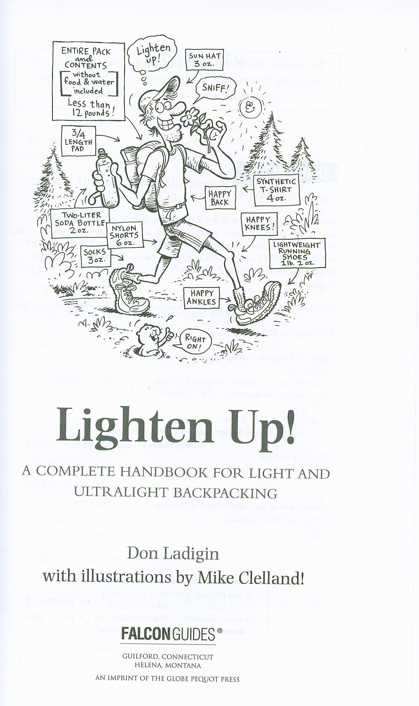 ENTIRE PACK ~ CONTENTS tood & :J ~"'ithOU"t \NClter ",,,duded Less thah \1. pouhd 5 I Lighten Up! A COMPLETE HANDBOOK FOR LIGHT AND ULTRALIGHT BACKPACKING Don Ladiginwith illustrations by Mike Clelland!FALCON GUIDES @ GUILfORD, CONNECTICUT HELENA, MONTANA AN IMPRINT Of THE GLOBE PEQjJOT PRESS
ENTIRE PACK ~ CONTENTS tood & :J ~"'ithOU"t \NClter ",,,duded Less thah \1. pouhd 5 I Lighten Up! A COMPLETE HANDBOOK FOR LIGHT AND ULTRALIGHT BACKPACKING Don Ladiginwith illustrations by Mike Clelland!FALCON GUIDES @ GUILfORD, CONNECTICUT HELENA, MONTANA AN IMPRINT Of THE GLOBE PEQjJOT PRESS 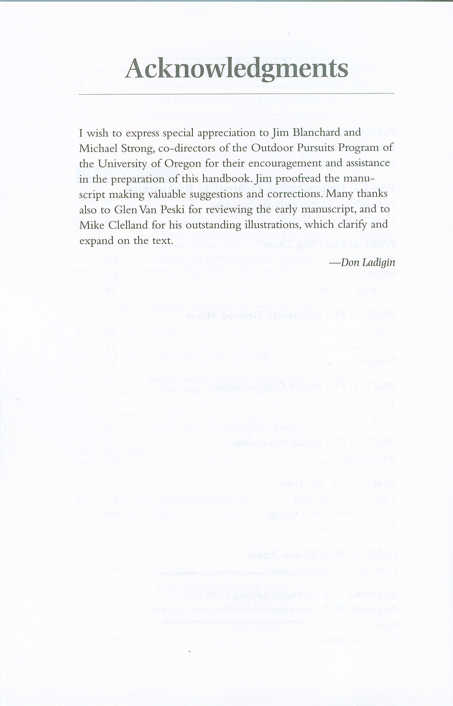 Acl<:nowledgments I wish to express special appreciation to Jim Blanchard and Michael Strong, co-directors of the Outdoor Pursuits Program of the University of Oregon for their encouragement and assistance in the preparation of this handbook. Jim proofread the manuscript making valuable suggestions and corrections. Many thanks also to Glen Van Peski for reviewing the early manuscript, and to Mike Clelland for his outstanding illustrations, which clarity and expand on the text. -Don Ladigin
Acl<:nowledgments I wish to express special appreciation to Jim Blanchard and Michael Strong, co-directors of the Outdoor Pursuits Program of the University of Oregon for their encouragement and assistance in the preparation of this handbook. Jim proofread the manuscript making valuable suggestions and corrections. Many thanks also to Glen Van Peski for reviewing the early manuscript, and to Mike Clelland for his outstanding illustrations, which clarity and expand on the text. -Don Ladigin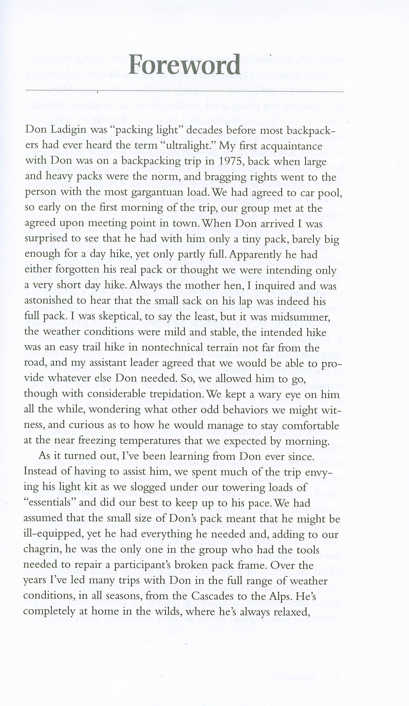 Foreword Don Ladigin was "packing light" decades before most backpackers had ever heard the term "ultralight." My first acquaintance with Don was on a backpacking trip in 1975, back when large and heavy packs were the norm, and bragging rights went to the person with the most gargantuan load. We had agreed to car pool, so early on the first morning of the trip, our group met at the agreed upon meeting point in town.
Foreword Don Ladigin was "packing light" decades before most backpackers had ever heard the term "ultralight." My first acquaintance with Don was on a backpacking trip in 1975, back when large and heavy packs were the norm, and bragging rights went to the person with the most gargantuan load. We had agreed to car pool, so early on the first morning of the trip, our group met at the agreed upon meeting point in town.
When Don arrived I was surprised to see that he had with him only a tiny pack, barely big enough for a day hike, yet only partly full. Apparently he had either forgotten his real pack or thought we were intending only a very short day hike. Always the mother hen, I inquired and was astonished to hear that the small sack on his lap was indeed his full pack. I was skeptical, to say the least, but it was midsummer, the weather conditions were mild and stable, the intended hike was an easy trail hike in nontechnical terrain not far from the road, and my assistant leader agreed that we would be able to provide whatever else Don needed. So, we allowed him to go, though with considerable trepidation. We kept a wary eye on him all the while, wondering what other odd behaviors we might wit-ness, and curious as to how he would manage to stay comfortable at the near freezing temperatures that we expected by morning.
As it turned out, I've been learning from Don ever since. Instead of having to assist him, we spent much of the trip envy-ing his light kit as we slogged under our towering loads of "essentials" and did our best to keep up to his pace. We had assumed that the small size of Don's pack meant that he might be ill-equipped, yet he had everything he needed and, adding to our chagrin, he was the only one in the group who had the tools needed to repair a participant's broken pack frame. Over the years I've led many trips with Don in the full range of weather conditions, in all seasons, from the Cascades to the Alps. He's completely at home in the wilds, where he's always relaxed, 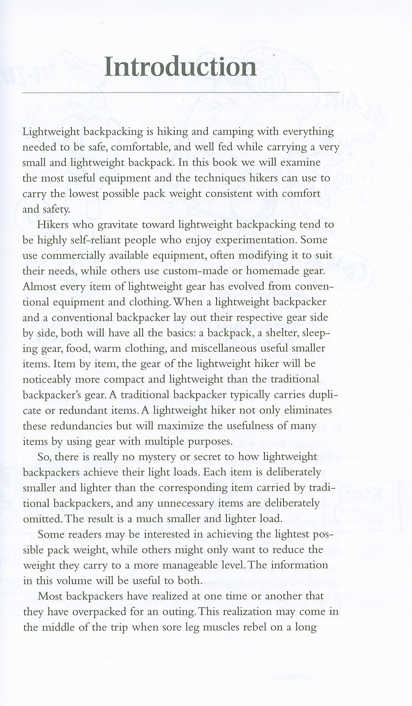 Introduction Lightweight backpacking is hiking and camping with everything needed to be safe, comfortable, and well fed while carrying a very small and lightweight backpack. In this book we will examine the most useful equipment and the techniques hikers can use to carry the lowest possible pack weight consistent with comfort and safety.
Introduction Lightweight backpacking is hiking and camping with everything needed to be safe, comfortable, and well fed while carrying a very small and lightweight backpack. In this book we will examine the most useful equipment and the techniques hikers can use to carry the lowest possible pack weight consistent with comfort and safety.
Hikers who gravitate toward lightweight backpacking tend to be highly self-reliant people who enjoy experimentation. Some use commercially available equipment, often modifYing it to suit their needs, while others use custom-made or homemade gear. Almost every item of lightweight gear has evolved from conven tional equipment and clothing. When a lightweight backpacker and a conventional backpacker layout their respective gear side by side, both will have all the basics: a backpack, a shelter, sleeping gear, food, warm clothing, and miscellaneous useful smaller items. Item by item, the gear of the lightweight hiker will be noticeably more compact and lightweight than the traditional backpacker's gear. A traditional backpacker typically carries dupli-cate or redundant items.
A lightweight hiker not only eliminates these redundancies but will maximize the usefulness of many items by using gear with multiple purposes. So, there is really no mystery or secret to how lightweight backpackers achieve their light loads. Each item is deliberately smaller and lighter than the corresponding item carried by traditional backpackers, and any unnecessary items are deliberately omitted. The result is a much smaller and lighter load. Some readers may be interested in achieving the lightest possible pack weight, while others might only want to reduce the weight they carry to a more manageable level. The information in this volume will be useful to both.
Most backpackers have realized at one time or another that they have overpacked for an outing. This realization may come in the middle of the trip when sore leg muscles rebel on a long  TRADlTlot>JAL UL1R~ lie:. HTBACI<"AC\BA(\climb uphill, or it may come at the end of a trip while unpacking large amounts of leftover food. Aside from what gets consumed during the hike, everythinghikers put into a backpack will have to be carried for many miles, then carried back out again. Even small, light items will add up: Those many small weights become a single large weight once they're on a hiker's back.Hikers who carry less weight spend less energy and can hike faster and farther when they want to. They will have greater agility fording streams and crossing slippery logs.
TRADlTlot>JAL UL1R~ lie:. HTBACI<"AC\BA(\climb uphill, or it may come at the end of a trip while unpacking large amounts of leftover food. Aside from what gets consumed during the hike, everythinghikers put into a backpack will have to be carried for many miles, then carried back out again. Even small, light items will add up: Those many small weights become a single large weight once they're on a hiker's back.Hikers who carry less weight spend less energy and can hike faster and farther when they want to. They will have greater agility fording streams and crossing slippery logs.
If they stumble, they are less likely to fall, and when they do fall they are less likely to get hurt. A hiker who is less fatigued is more capable of helping others who are tired or injured. Hikers with interests such as photography or climbing are able to carry more of their specialized equipment when the rest of their gear is lightweight. A lighter load also allows the use of lighter boots, which save the hiker's energy and are gentler on the trail. x Introduction 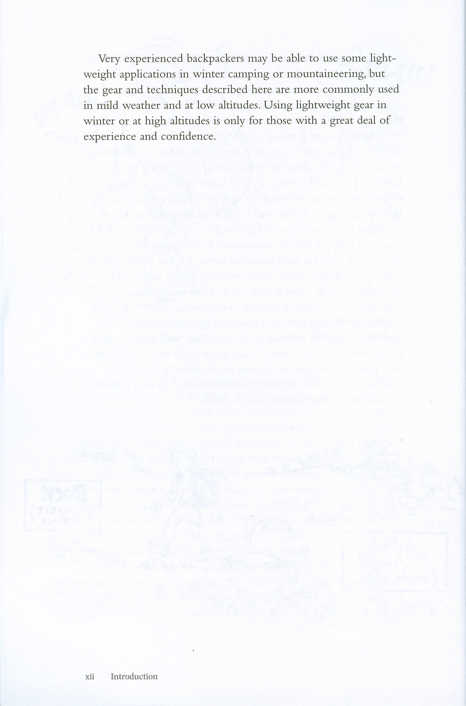 Very experienced backpackers may be able to use some lightweight applications in winter camping or mountaineering, but the gear and techniques described here are more commonly used in mild weather and at low altitudes. xii Introduction
Very experienced backpackers may be able to use some lightweight applications in winter camping or mountaineering, but the gear and techniques described here are more commonly used in mild weather and at low altitudes. xii Introduction 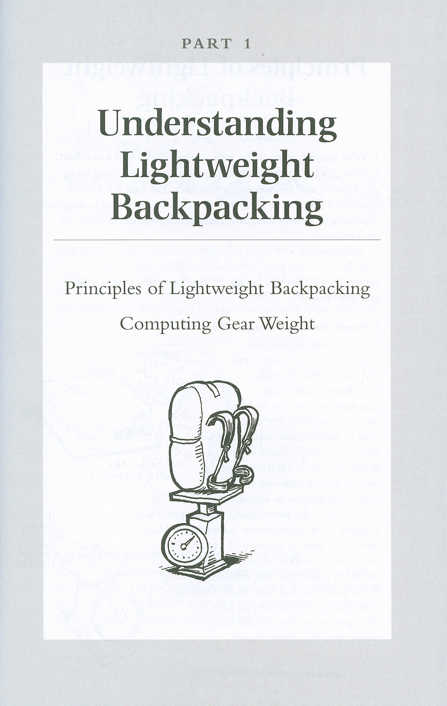 PART UnderstandingLightweightBackpacking Principles of Lightweight Backpacking Computing Gear Weight
PART UnderstandingLightweightBackpacking Principles of Lightweight Backpacking Computing Gear Weight 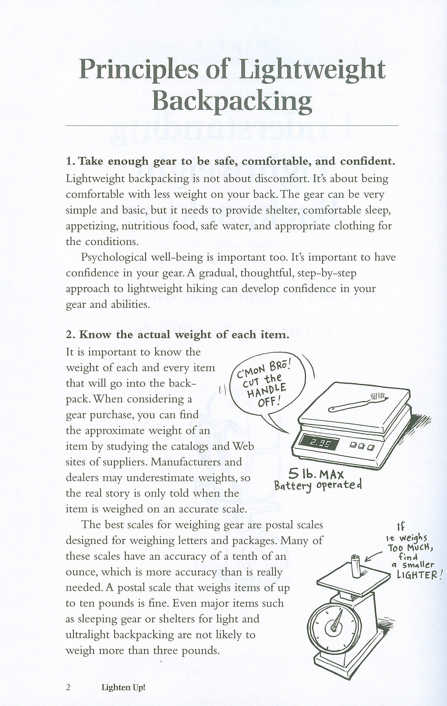 Principles of LightweightBacl(pacl(ing1. xii Introduction
Principles of LightweightBacl(pacl(ing1. xii Introduction 
Next page
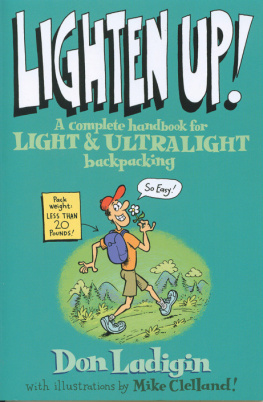




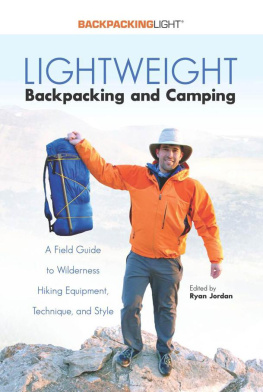
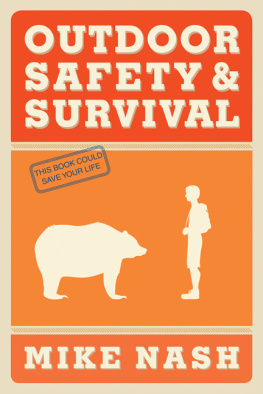


 ENTIRE PACK ~ CONTENTS tood & :J ~"'ithOU"t \NClter ",,,duded Less thah \1. pouhd 5 I Lighten Up! A COMPLETE HANDBOOK FOR LIGHT AND ULTRALIGHT BACKPACKING Don Ladiginwith illustrations by Mike Clelland!FALCON GUIDES @ GUILfORD, CONNECTICUT HELENA, MONTANA AN IMPRINT Of THE GLOBE PEQjJOT PRESS
ENTIRE PACK ~ CONTENTS tood & :J ~"'ithOU"t \NClter ",,,duded Less thah \1. pouhd 5 I Lighten Up! A COMPLETE HANDBOOK FOR LIGHT AND ULTRALIGHT BACKPACKING Don Ladiginwith illustrations by Mike Clelland!FALCON GUIDES @ GUILfORD, CONNECTICUT HELENA, MONTANA AN IMPRINT Of THE GLOBE PEQjJOT PRESS  Acl<:nowledgments I wish to express special appreciation to Jim Blanchard and Michael Strong, co-directors of the Outdoor Pursuits Program of the University of Oregon for their encouragement and assistance in the preparation of this handbook. Jim proofread the manuscript making valuable suggestions and corrections. Many thanks also to Glen Van Peski for reviewing the early manuscript, and to Mike Clelland for his outstanding illustrations, which clarity and expand on the text. -Don Ladigin
Acl<:nowledgments I wish to express special appreciation to Jim Blanchard and Michael Strong, co-directors of the Outdoor Pursuits Program of the University of Oregon for their encouragement and assistance in the preparation of this handbook. Jim proofread the manuscript making valuable suggestions and corrections. Many thanks also to Glen Van Peski for reviewing the early manuscript, and to Mike Clelland for his outstanding illustrations, which clarity and expand on the text. -Don Ladigin Foreword Don Ladigin was "packing light" decades before most backpackers had ever heard the term "ultralight." My first acquaintance with Don was on a backpacking trip in 1975, back when large and heavy packs were the norm, and bragging rights went to the person with the most gargantuan load. We had agreed to car pool, so early on the first morning of the trip, our group met at the agreed upon meeting point in town.
Foreword Don Ladigin was "packing light" decades before most backpackers had ever heard the term "ultralight." My first acquaintance with Don was on a backpacking trip in 1975, back when large and heavy packs were the norm, and bragging rights went to the person with the most gargantuan load. We had agreed to car pool, so early on the first morning of the trip, our group met at the agreed upon meeting point in town. Introduction Lightweight backpacking is hiking and camping with everything needed to be safe, comfortable, and well fed while carrying a very small and lightweight backpack. In this book we will examine the most useful equipment and the techniques hikers can use to carry the lowest possible pack weight consistent with comfort and safety.
Introduction Lightweight backpacking is hiking and camping with everything needed to be safe, comfortable, and well fed while carrying a very small and lightweight backpack. In this book we will examine the most useful equipment and the techniques hikers can use to carry the lowest possible pack weight consistent with comfort and safety. TRADlTlot>JAL UL1R~ lie:. HTBACI<"AC\BA(\climb uphill, or it may come at the end of a trip while unpacking large amounts of leftover food. Aside from what gets consumed during the hike, everythinghikers put into a backpack will have to be carried for many miles, then carried back out again. Even small, light items will add up: Those many small weights become a single large weight once they're on a hiker's back.Hikers who carry less weight spend less energy and can hike faster and farther when they want to. They will have greater agility fording streams and crossing slippery logs.
TRADlTlot>JAL UL1R~ lie:. HTBACI<"AC\BA(\climb uphill, or it may come at the end of a trip while unpacking large amounts of leftover food. Aside from what gets consumed during the hike, everythinghikers put into a backpack will have to be carried for many miles, then carried back out again. Even small, light items will add up: Those many small weights become a single large weight once they're on a hiker's back.Hikers who carry less weight spend less energy and can hike faster and farther when they want to. They will have greater agility fording streams and crossing slippery logs. Very experienced backpackers may be able to use some lightweight applications in winter camping or mountaineering, but the gear and techniques described here are more commonly used in mild weather and at low altitudes. xii Introduction
Very experienced backpackers may be able to use some lightweight applications in winter camping or mountaineering, but the gear and techniques described here are more commonly used in mild weather and at low altitudes. xii Introduction  PART UnderstandingLightweightBackpacking Principles of Lightweight Backpacking Computing Gear Weight
PART UnderstandingLightweightBackpacking Principles of Lightweight Backpacking Computing Gear Weight  Principles of LightweightBacl(pacl(ing1. xii Introduction
Principles of LightweightBacl(pacl(ing1. xii Introduction